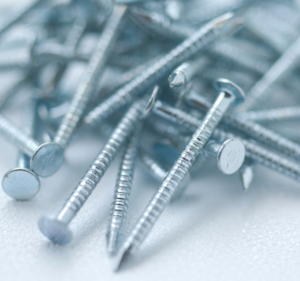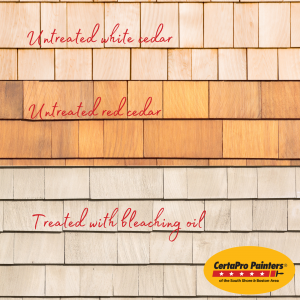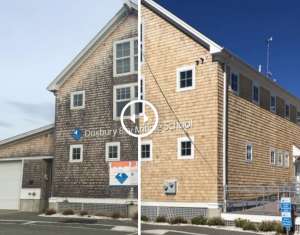Cedar Shingle Staining Services
on the South Shore, South Coast, Plymouth & Boston Area
House Painting > Exterior House Painting > Cedar Shingle Staining Services
Cedar Siding Shingles are a staple on the South Shore and in the Boston area.
Some Clients prefer their cedar shingles to weather to the seaside gray common on Nantucket homes and up and down coastal New England, and other Clients choose to stain their shingles with a stain.
To gray your cedar shingles: We can apply bleaching stain to both red cedar and white cedar shingles to help them to gray over time.
To stain your cedar shingles and still see the wood grain: We can apply translucent stain.
To stain your cedar shingles so no wood grain shows: We can apply a solid stain. Using a solid stain in a color close to the natural color of a cedar shingle helps them remain newer-looking.
The black you see on your shingles is likely mold or mildew. We can power wash the mold off and treat the shingles with stain to help clean and protect them.
The dark brown you see on your shingles are the natural tannins inside the wood. Tannins naturally occur within the wood shingle and will turn your home a dark brown over time. To block the tannins, we recommend a slow-drying oil primer. Using a slow-drying primer will allow the primer to seep into the wood shingle for a longer time vs. a regular primer, helping to protect the shingles from tannin-bleed.
Get started by setting up a free estimate appointment with our team.

Shingle siding – a staple of South Shore homes
Cedar shingle siding is a staple on most South Shore homes. If your home has one or more sides that contain shingles, it’s important to wash, stain, and maintain them to prolong their life and keep them looking beautiful.
Here are some commonly asked questions about South Shore cedar shingle siding:
Question: I have a few missing shingles what kind of nails do I use to affix them to my home?
Stainless steel nails are preferred on exterior applications because they provide the highest degree of corrosion resistance. Stainless steel also won’t rust and then “run” down the side of the home.
We generally use 2″ ring shank stainless steel nails recommended by the shingle manufacturer. Ring shank nails have threads along the shank of the nail that help divide the wood fibers, so the wood resists removal.
Question: Where do I nail my cedar shingle on my siding?

Each shingle will be a different width, so how many nails you use to affix each one to your home depends on the width of the shingle:
On wider shingles, use two stainless steel nails about 3/4″ from the edge of the shingle (if the shingle is wider than 5 inches, you can add a third nail in the middle).
On narrower shingles, you may be able to get away with one nail in the middle of the shingle.
Question: What’s the best way to install a cedar shingle?
1. Nudge the shingles next to each other without forcing them together, leaving a gap between them. The gap is an important part of the functionality of the shingles.
2. Drive the stainless steel nail in gently and evenly with the face, as shingles are prone to splitting.
3. Do not countersink the nail. Conversely, do not underdrive the nail so the nail head is slightly above the surface of the shingle. It is best when the nail head is flush with the shingle’s surface.
4. Don’t affix the shingle so tightly to your surface that there is not venting behind it. Venting is imperative for the longevity of the shingles as well as to reduce mildew from growing.
Question: Can I use staples to affix the shingles to my home?
Stapling shingles is NOT our preferred method, but if you do use them make sure they are stainless steel staples that are about ½” wide.
Question: Can cedar shingles be painted, or is it better to stain them?
While we prefer staining your shingles, but if you decide to paint them the wood’s natural grain will not show through the paint. Paint sits atop your shingle, while stain seeps into it, protecting it both on the outside and from within. To paint a shingle, be sure to apply a stain-blocking primer before applying two coats of exterior paint.
Staining your cedar siding protects it, seeps inside the wood, and allows the shingles’ wood grain to show through. Most of the time, we use transparent, semi-solid, and solid stains on cedar shingle siding. Transparent stains allow the wood grain to show while semi-solid and solid stains increasingly hide the wood grain of the shingles.
If you love the look of raw cedar shingle siding but want the wood to be protected, we can apply a transparent stain that shows the grain and texture of the wood. Understand that clear stains need to be applied more frequently than more opaque stains.
Question: Why do cedar shingles turn black?


Shingles turn black for two reasons:
1. Tannins that come from within the cedar to the surface of the wood. Generally, the dark tannins are a very dark brown in color.
2. Mildew stains.
If the dark color is mildew, bleach will clear it up. If tannin causes a stain, bleach will not lighten the darkened shingle.
Are cedar shingles waterproof?
This is a tricky question because wood, in general, is quite absorbent. Two things can help wood become more water-resistant:
- The stain or paint with which you treat the shingles
- The way shingles are installed in an overlapping fashion with venting behind them to help dry them out quicker.
Question: can you show me the difference between shakes and shingles?

Have more questions about your shingle siding? Email [email protected]. We’re happy to answer your questions about installing shingles, even if you’re doing the project yourself.


